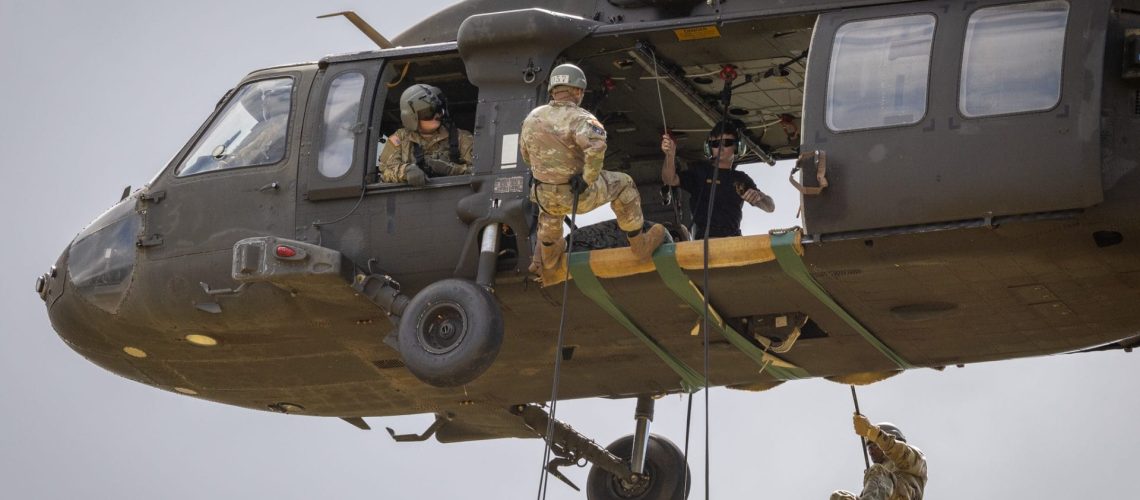Photo: a Black Hawk of the 25th Combat Aviation Brigade training for assault operations © Sergeant Olivia Cowart, U.S. Army, Hawaii, September 2025
The increased “dronification” of the battlefield has prompted a broad debate within the armed forces of many nations about the possible elimination of certain crewed combat units in favor of autonomous systems. Countries that maintain an aviation component within their land forces have been particularly prone to debate their evolution, and/or, in some cases, their very continuation.
The U.S. Army Aviation has chosen a middle path, i.e. rebalancing and modernizing so that a new sharing of missions occurs between its manned and unmanned components.
Senior leaders of the U.S. Army have thus reaffirmed the essential role of Army Aviation and therefore the legitimacy of its existence, while stressing the imperative to adapt to the changing nature of modern conflict.
Major Montrell Russell, spokesperson for U.S. Army Aviation, described that constraint as follows:
“While Army aviation remains an essential member of the combined arms team, the use of airspace for maneuver that was once unique to our aviation formations is now becoming accessible to Soldiers in multiple formations via drone technology, reducing training requirements for conducting such operations”, (1)
If the use of drones is accessible to all units, what is less so is their integration into an integrated air land maneuver that must favor “speed over weight” and “decisive force over mass” within the framework of the Army Transformation Initiative launched last May (2).
In a letter co-signed by Dan Driscoll, Under Secretary of the U.S. Army, and General Randy George, Chief of Staff of the Army, the ATI — Army Transformation Initiative — is described as following on from a Department of Defense directive dated April 30, 2025, titled “Army Transformation and Acquisition Reform.”
One of the objective is in particular to adapt the U.S. Army to the rise of autonomous systems, sensors, dual-use technologies, and the rapid evolution of adversary capabilities, by revising its organization, training, combat methods and acquisition processes.
Three lines of effort are emphasized:
– Strengthening capabilities to integrate in particular long-range missiles and modern UAS and reinforce command-and-control systems with the addition of AI.
– A structural optimization aimed at eliminating redundancies and focusing more on combat forces: each aviation brigade will see the elimination of one aerial cavalry squadron, while infantry brigades will be converted to mobile brigade combat teams.
– Cancelling obsolete or programs that are considered not sufficiently cost-effective, such as the AH-64D Apache helicopter, but also the Gray Eagle drone. (3)
It is in this context that the announcement made on September 19th stated that the US Army plans to cut 6,500 positions in its Aviation units during fiscal years 2026 and 2027. (4)
This choice rests on a number of well-known, tangible arguments: autonomous systems reduce human risk by removing crew exposure in hostile areas; their long-term operational, maintenance and logistics costs are often lower than those of crewed helicopters; finally, recent conflicts have demonstrated the effectiveness of drone swarms to saturate enemy defenses at low cost. (4)
On the opposite, the importance of crewed platforms remains undeniable. Faced with unforeseen weather conditions, jamming or complex scenarios, human decision-making remains an indisputable advantage, while the ability to carry out demanding missions — medical evacuation, tactical transport, close air support, in- or exfiltration missions — in dynamic contexts continues to rely fully on traditional aviation.
Corresponding to the “automation” of certain missions such as ISR, planned fire support, saturation of enemy defenses or even deception operations (7), this 20% reduction of the Army’s aviation component includes pilots, crews and maintainers. Some of them will be redirected to other missions within Aviation units whose modernization opens new possibilities (for example with the acquisition of the FLRAA — Future Long-Range Assault Aircraft). (7)
One of the questions, of course, is of course how to retrain manpower toward the world of drones, which can prove delicate for crews and/or maintainers who may prefer to leave the Army for the civilian sector.
Integration into the Reserve and the U.S. National Guard is also among the options considered by the U.S. Army, which is currently examining this issue, while attempting to manage this doctrinal and human shift without too much of a rough break.
By Murielle Delaporte
Notes and sources
(1) Quote as published in: https://www.militarytimes.com/news/your-army/2025/09/19/army-to-cut-6500-active-duty-aviation-jobs-over-next-2-years/
(2) Letter co-signed by the Chief of Staff of the Army, General Randy George, and the Under Secretary of the Army, Daniel Driscoll, as quoted in: https://www.stripes.com/branches/army/2025-05-02/army-transformation-plan-17654128.html
(3) https://www.army.mil/article/285100/letter_to_the_force_army_transformation_initiative
(4) https://www.armytimes.com/news/your-army/2025/09/19/army-to-cut-6500-active-duty-aviation-jobs-over-next-2-years; https://thedefensepost.com/2025/09/23/us-army-aviation-job-cuts/
(5) https://warroom.armywarcollege.edu/articles/transform-for-drones
(6) https://www.flightglobal.com/helicopters/bell-secures-osprey-production-though-2027-spanning-gap-until-flraa-work-begins/162737.article
(7) In a January 2025 article, Charlie Phelps describes trends in drone deception as follows:
“Another element of the swarm focused on deception. Hundreds of 3D printed, ultracheap drones, barely more than styrofoam wings and GPS chips, buzzed toward enemy formations broadcasting false signatures. Some carried heat packs to mimic vehicle infrared signatures; others transmitted spoofed radio traffic suggesting a US mechanized brigade was massing just beyond the ridgeline. The adversary’s radar operators reported swarms of contacts that cluttered their picture, forcing them to extend radar queuing and emission while expending expensive surface-to-air missiles on worthless targets.”
(https://mwi.westpoint.edu/let-them-fly-to-generate-drone-combat-readiness-army-installations-must-step-up/)
